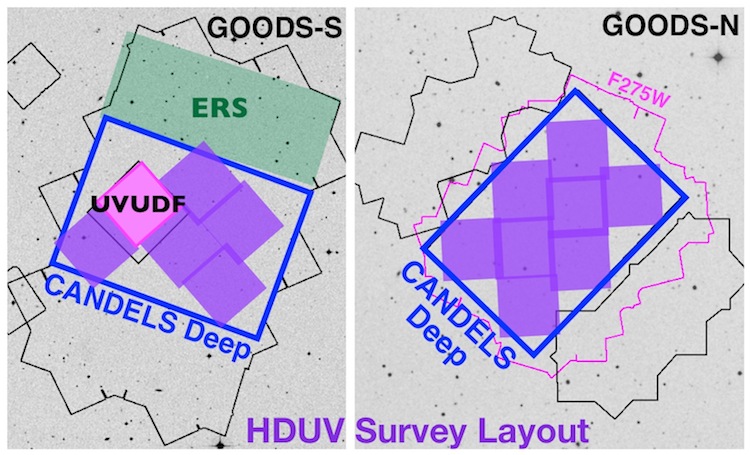Survey
PROPOSAL ABSTRACT:
Deep HST imaging has shown that the overall star formation density and UV light density at z>3 is dominated by faint, blue galaxies. Remarkably, very little is known about the equivalent galaxy population at lower redshifts. Understanding how these galaxies evolve across the epoch of peak cosmic star-formation is key to a complete picture of galaxy evolution. While we and others have been making every effort to use existing UV imaging data, a large fraction of the prior data were taken without post-flash and are not photometric. We now propose to obtain a robust legacy dataset for a complete census of faint star-forming galaxies at z~0.5-2, akin to what is achieved at z>3, using the unique capabilities of the WFC3/UVIS camera to obtain very deep UV imaging to 27.5-28.0 mag over the CANDELS Deep fields in GOODS North and South. We directly sample the FUV at z>~0.5 and we make these prime legacy fields for JWST with unique and essential UV/blue HST coverage. Together with the exquisite ancillary multi-wavelength data at high spatial resolution from ACS and WFC3/IR our program will result in accurate photometric redshifts for very faint sources and will enable a wealth of research by the community. This includes tracing the evolution of the FUV luminosity function over the peak of the star formation rate density from z~3 down to z~0.5, measuring the physical properties of sub-L* galaxies, and characterizing resolved stellar populations to decipher the build-up of the Hubble sequence from sub-galactic clumps. The lack of a future UV space telescope makes the acquisition of such legacy data imperative for the JWST era and beyond.
HDUV SURVEY LAYOUT:

The HDUV survey is designed to efficiently cover most of the CANDELS-DEEP region with F275W and F336W imaging while building on existing data. The GOODS-South region (left panel) contains the very deep UVUDF imaging by Teplitz et al, and the HDUV survey got 5 pointings built around that. In GOODS-North (right panel), CANDELS obtained previous F275W data (pink outline) which were taken during the bright part of CVZ orbits. The HDUV built on these exposures by adding 4 orbits of additional F275W data as well as 8 orbits of F336W imaging over 8 pointings.
Paper:
For more information please consult the survey paper: Oesch et al. (2018), ApJS
Team:
The HDUV survey team includes: P. Oesch, M. Montes, N. Reddy, R. J. Bouwens, G. D. Illingworth, D. Magee, H. Atek, C. M. Carollo, A. Cibinel, M. Franx, B. Holden, I. Labbe, E. J. Nelson, C. C. Steidel, P. G. van Dokkum, L. Morselli, R. P. Naidu, S. Wilkins.